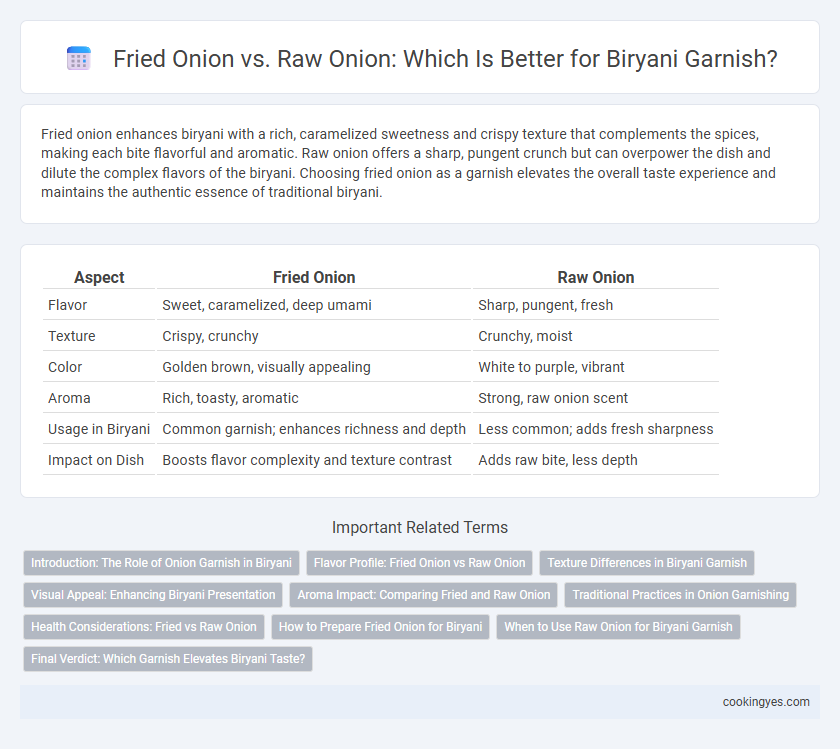Fried onion enhances biryani with a rich, caramelized sweetness and crispy texture that complements the spices, making each bite flavorful and aromatic. Raw onion offers a sharp, pungent crunch but can overpower the dish and dilute the complex flavors of the biryani. Choosing fried onion as a garnish elevates the overall taste experience and maintains the authentic essence of traditional biryani.
Table of Comparison
| Aspect | Fried Onion | Raw Onion |
|---|---|---|
| Flavor | Sweet, caramelized, deep umami | Sharp, pungent, fresh |
| Texture | Crispy, crunchy | Crunchy, moist |
| Color | Golden brown, visually appealing | White to purple, vibrant |
| Aroma | Rich, toasty, aromatic | Strong, raw onion scent |
| Usage in Biryani | Common garnish; enhances richness and depth | Less common; adds fresh sharpness |
| Impact on Dish | Boosts flavor complexity and texture contrast | Adds raw bite, less depth |
Introduction: The Role of Onion Garnish in Biryani
Onion garnish in biryani plays a crucial role in enhancing both flavor and texture, with fried onions adding a sweet, caramelized crunch that deepens the dish's aromatic profile. Raw onions provide a sharp, pungent contrast that can highlight freshness and balance the rich spices but may overpower the delicate layers if used excessively. Choosing between fried and raw onions depends on the desired flavor complexity and mouthfeel, as fried onions contribute sweetness and softness, while raw onions bring crispness and a biting zest.
Flavor Profile: Fried Onion vs Raw Onion
Fried onions impart a rich, caramelized sweetness and a crispy texture that enhances the depth of biryani's flavor profile, creating a more complex and aromatic experience. Raw onions contribute a sharp, pungent bite with a crunchy freshness that contrasts the soft, spiced rice, adding a vibrant layer to the dish. The choice between fried and raw onions significantly influences the balance between savory sweetness and sharp tang in biryani garnishing.
Texture Differences in Biryani Garnish
Fried onions in biryani garnish provide a crispy, caramelized texture that contrasts with the soft, tender layers of the rice and meat, enhancing the overall mouthfeel. Raw onions offer a crunchy, slightly sharp bite that adds freshness but can overpower the delicate spices in the dish. Choosing fried onions creates a harmonious texture blend, while raw onions introduce a bold crispness that changes the traditional sensory balance of biryani.
Visual Appeal: Enhancing Biryani Presentation
Fried onions add a rich golden-brown hue and a crispy texture that significantly enhances the visual appeal of biryani, making the dish look more appetizing and inviting. Raw onions, while adding a fresh crunch and a pop of white or purple color, may not complement the warm tones of biryani as effectively as fried onions. The caramelized sheen of fried onions creates an appealing contrast against the vibrant saffron and turmeric-infused rice, elevating the overall presentation.
Aroma Impact: Comparing Fried and Raw Onion
Fried onions release rich, caramelized aromas that intensify the overall fragrance of biryani, creating a warm, savory depth that raw onions cannot match. Raw onions contribute a sharp, pungent scent that may overpower the delicate balance of spices in biryani, reducing the dish's aromatic appeal. The Maillard reaction in fried onions enhances the umami essence, making them the preferred garnish for boosting biryani's signature aroma.
Traditional Practices in Onion Garnishing
Traditional biryani garnishing predominantly features fried onions, known as "birista," which impart a rich, caramelized sweetness and crispy texture essential for authentic flavor and presentation. Raw onions are rarely used as a garnish because they lack the depth of flavor and mouthfeel that fried onions provide, which enhances the biryani's aroma and visual appeal. The time-honored practice of slow-frying thinly sliced onions until golden brown is crucial for achieving the signature taste profile and layered complexity in biryani recipes across Indian and South Asian cuisines.
Health Considerations: Fried vs Raw Onion
Fried onions used as a garnish in biryani contain higher levels of acrylamide, a potential carcinogen formed during high-temperature cooking, which may pose health risks when consumed in large quantities. Raw onions retain more antioxidants, such as quercetin, which contribute to anti-inflammatory and cardiovascular benefits. Choosing raw onion garnish in biryani preserves essential nutrients and reduces exposure to harmful compounds associated with frying.
How to Prepare Fried Onion for Biryani
Fried onions are essential for authentic biryani garnish, offering a rich, caramelized sweetness and crunchy texture that raw onions cannot provide. To prepare fried onions, thinly slice onions and soak them in water for 10-15 minutes to reduce sharpness, then drain thoroughly and pat dry to prevent splattering during frying. Fry the onions in hot oil over medium heat, stirring frequently until they turn golden brown and crisp, then drain on paper towels to absorb excess oil before sprinkling over biryani.
When to Use Raw Onion for Biryani Garnish
Raw onion is ideal for biryani garnishing when a fresh, sharp crunch and pungent flavor are desired to contrast the rich, spiced layers of the dish. It works best in lighter biryanis such as chicken or vegetable varieties, where the natural crispness of raw onion enhances texture without overwhelming delicate flavors. Using thinly sliced raw onion also adds a vibrant, slightly sweet bite that balances the aromatic herbs and spices in biryani.
Final Verdict: Which Garnish Elevates Biryani Taste?
Fried onions enhance biryani by adding a crispy texture and deep caramelized flavor that intensifies the dish's aroma and richness. Raw onions provide a fresh, sharp crunch but can overpower the delicate spices and reduce the biryani's cohesive taste profile. The final verdict favors fried onions as the superior garnish, elevating both flavor complexity and presentation.
Fried Onion vs Raw Onion for Biryani Garnish Infographic

 cookingyes.com
cookingyes.com